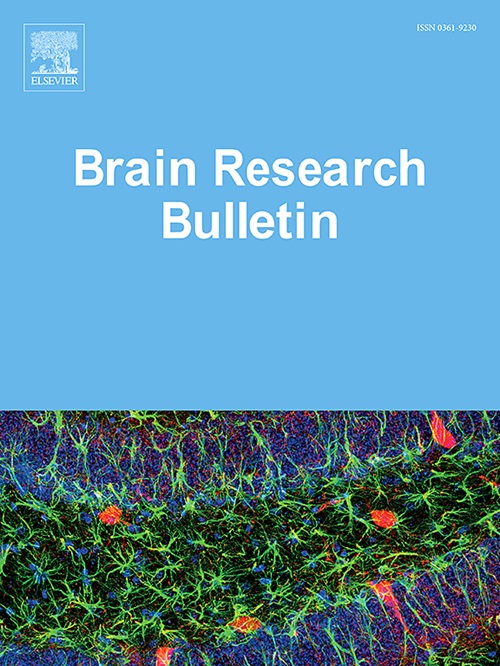阿尔茨海默病的淋巴系统特征和早期β-淀粉样蛋白成像:PET/MR同步研究
IF 3.5
3区 医学
Q2 NEUROSCIENCES
引用次数: 0
摘要
早期a β成像可以检测脑灌注缺陷,而淋巴功能障碍是包括阿尔茨海默病(AD)在内的神经退行性疾病的关键事件。然而,它们在AD连续体中的关系尚不清楚。本研究旨在利用PET/MR同时检测健康对照组(HC)、前驱AD (PAD)和AD患者的认知功能障碍,评估淋巴系统(沿血管周围空间扩散张量图像分析、DTI-ALPS)和早期Aβ成像在认知功能障碍中的作用。它还检查了灌注损伤和淋巴功能障碍中基线淀粉样蛋白(Aβ)负荷和血管负荷之间的相互作用。AD患者双侧海马、海马旁和尾状体早期期Aβ的SUVr较低(P均为 <; 0.05),表明这些区域存在灌注缺陷。与HC相比,AD组和PAD组的平均alps指数较低(P <; 0.001),提示淋巴功能障碍是AD的早期事件。平均alps指数与双侧海马、海马旁、尾状体和丘脑早期Aβ摄取呈正相关(P均为 <; 0.001)。中介分析显示,alps指数在灌注不足与认知功能障碍之间起着重要的中介作用。基线Aβ负荷和早期Aβ灌注不足通过血管负荷(PVS或WMH)影响ALPS-index,而早期Aβ灌注也直接影响ALPS-index。总之,本研究强调了淋巴功能障碍和脑灌注缺陷在AD连续体中的作用,强调了它们作为早期病理标志物的必要性。这些发现为阿尔茨海默病的早期诊断和个性化治疗提供了影像学依据。本文章由计算机程序翻译,如有差异,请以英文原文为准。
Characterization of the glymphatic system and early-phase β-amyloid imaging in Alzheimer's disease: A simultaneous PET/MR study
Early-phase Aβ imaging can detect cerebral perfusion deficits, while glymphatic dysfunction is a key event in neurodegenerative diseases, including Alzheimer's disease (AD). However, their relationship within the AD continuum remains unclear. This study aimed to evaluate the role of the glymphatic system (diffusion tensor image analysis along the perivascular space, DTI-ALPS) and early-phase Aβ imaging in cognitive impairment using simultaneous PET/MR in healthy control (HC), Prodromal AD (PAD), and AD. It also examines the interaction between baseline amyloid (Aβ) burden and vascular burden in perfusion impairment and glymphatic dysfunction. AD patients showed lower SUVr of early-phase Aβ in the bilateral hippocampus, parahippocampal, and caudate (all P < 0.05), indicating perfusion deficits in these regions. Compared to HC, a lower mean ALPS-index was found in the AD and PAD groups (P < 0.001), suggesting that glymphatic dysfunction is an early event in AD. The mean ALPS-index was positively correlated with early-phase Aβ uptake in the bilateral hippocampus, parahippocampal, caudate, and thalamus (all P < 0.001). Mediation analysis revealed that the ALPS-index plays a crucial mediating role between perfusion deficits and cognitive impairment. Baseline Aβ burden and early-phase Aβ perfusion deficits affected the ALPS-index with the mediation of vascular burden (PVS or WMH), while early-phase Aβ perfusion also directly influenced the ALPS-index. In conclusion, this study highlights the role of glymphatic dysfunction and cerebral perfusion deficits in the AD continuum, emphasizing their necessity as early pathological markers. These findings provide imaging evidence for early diagnosis and personalized management of AD.
求助全文
通过发布文献求助,成功后即可免费获取论文全文。
去求助
来源期刊

Brain Research Bulletin
医学-神经科学
CiteScore
6.90
自引率
2.60%
发文量
253
审稿时长
67 days
期刊介绍:
The Brain Research Bulletin (BRB) aims to publish novel work that advances our knowledge of molecular and cellular mechanisms that underlie neural network properties associated with behavior, cognition and other brain functions during neurodevelopment and in the adult. Although clinical research is out of the Journal''s scope, the BRB also aims to publish translation research that provides insight into biological mechanisms and processes associated with neurodegeneration mechanisms, neurological diseases and neuropsychiatric disorders. The Journal is especially interested in research using novel methodologies, such as optogenetics, multielectrode array recordings and life imaging in wild-type and genetically-modified animal models, with the goal to advance our understanding of how neurons, glia and networks function in vivo.
 求助内容:
求助内容: 应助结果提醒方式:
应助结果提醒方式:


